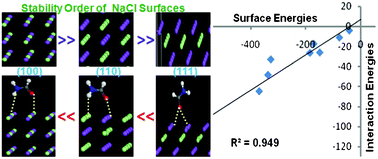Can surface energy be a parameter to define morphological change of rock-salt crystals with additives? A first principles study†
Abstract
We have reported that surface energy can be considered as a useful parameter to rationalize the morphology of rock-salt crystals in presence of an impurity. On the basis of first principles DFT calculations of the surface energies before and after the adsorption of surface-capping agent (additive) on the NaCl surfaces, we have shown that the surface energy differences among the three important faces (100), (110) and (111) corroborates the change in character of salt crystals observed experimentally. In accordance with the surface energy calculations, the stability order of the three crystallographic surfaces of NaCl was found to be (100) > (110) > (111) in the absence of additive molecules (i.e. clean surfaces). This result is in concurrence with the fact that salt crystals are cubes with (100) surface when grown in aqueous solution. The applied computational methodology towards the determination of surface energies was found to be trustworthy as it has reproduced well the experimental surface energy values of 189 erg cm−2 and 445 erg cm−2 for (100) and (110) NaCl surfaces, respectively. However, the trend in the decreased surface energy values has been found to be reversed for (100) < (110) < (111) when these surfaces were capped with known additive molecules. This work demonstrates that the change in the thermodynamic quantity (i.e. surface energy) in presence of additives can be an observable quantity, which can interface with the change in the shape of the crystals. The surface energy calculations have been computed at GGA/BLYP/DNP and GGA/VWN-BP/DNP level of theories using


 Please wait while we load your content...
Please wait while we load your content...